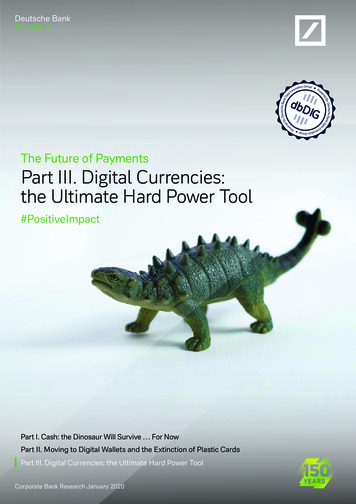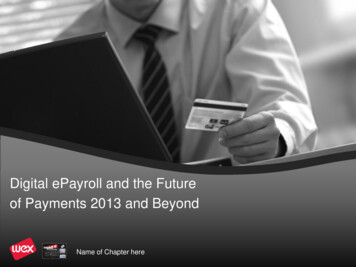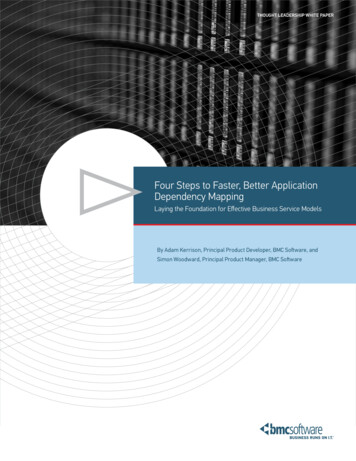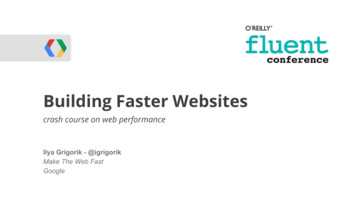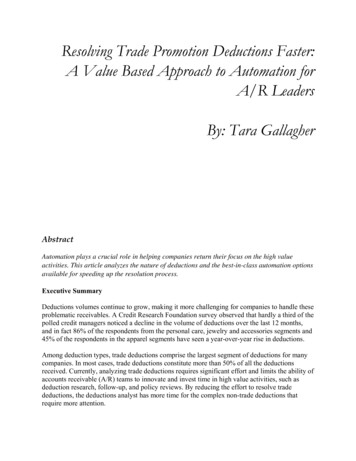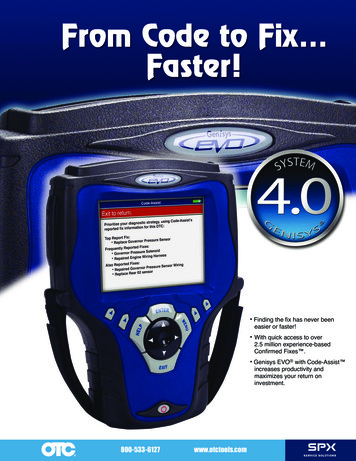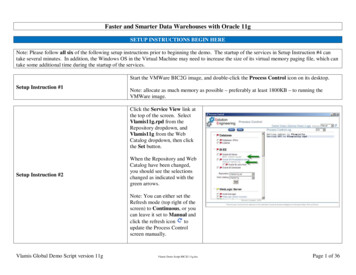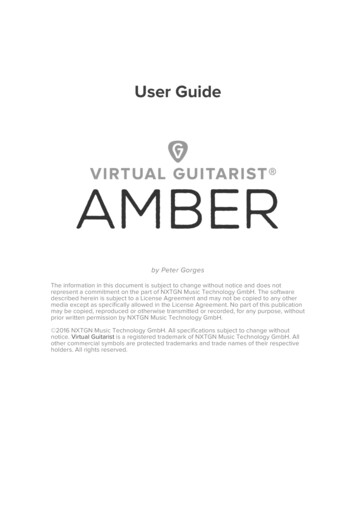Transcription
FasterPayments TrackerCMYCMMYCYCMYKDecember 2016Faster PaymentsFinds Its FutureNACHA reports same-day ACHpayments valued at almost 5 billionin October19 US financial institutions sign onto Early Warning’s instant paymentnetwork ZelleA recent survey found 90 percentof commercial banks consideringblockchain technology for payments
CMYCMMYCYCMYKFaster Payments Tracker What’s InsideFaster payments are living up to their namesake as October saw the rst full month of same-day ACHtransaction activity generate millions of dealings valued at billions of dollars.The results were strong during the first full month of same-day ACH transactions. NACHA reported almost 4million same-day transactions totaling close to 5 billion using the ACH Network.NACHA also released an ISO 20022-to-ACH mapping guide in an effort to offer financial institutions a tool tohelp them consistently support their business clients that want to integrate ISO 20022-formatted messagesinto the ACH Network.With faster payments on the rise, several institutions are considering new approaches to enable the quickexecution of new capabilities. This includes some unorthodox solutions like blockchain, which several bankshave expressed interest in adopting. But institutions are also realizing payments have to be as secure as theyare fast.Here’s what’s happening in the world of Faster Payments:Zelle saw a surge in popularity as 19 U.S. financial institutions representing 76 million consumers agreed touse the system. Meanwhile, Fiserv announced it would build upon its existing relationship with Early Warning toexpand the availability of real-time P2P payments to several major banks and credit unions.The move towards faster payments systems brings the need for heightened security. The Federal ReserveSystem’s Secure Payments Task Force is seeking comments on how to bolster security for faster paymenttransactions in the future, while InAuth and Early Warning partnered to improve security of real-time paymentservices in the mobile landscape.Several banks are looking into using blockchain services for real-time payments. Several banks, includingSweden’s SEB, are consider using Ripple’s digital currency for cross-border transactions. A survey of 10commercial banks from the U.S., Canada and Europe found 90 percent of respondents are mulling blockchaintechnology for payments.Check out the Tracker’s News section for the latest updates from across the Faster Payments landscape.Learning Faster Payments lessonsThis latest issue of the features a Q A with Jan Estep, NACHA’s president and CEO, about the busy year thatwas in faster payments, and what’s still to come in the year ahead.And, for this month’s cover story, PYMNTS spoke with ACI’s Barry Kislingbury, director of solution consulting,and WA Proctor, vice president and product line manager, about the rst few months of faster payments in theUnited States and what lessons American banks and nancial institutions can learn from Europe’s experiencewith faster payment initiates. 2016 PYMNTS.com all rights reserved2
Q&AQ&A with Jan Estep, NACHA’s president & CEOIt’s been a busy year in faster payments, and 2017 is shaping up to continue on the same trajectory. NACHAPresident and CEO Jan Estep explains.Looking back over the year, what were three of the biggest developments in the faster payments space, andhow was their impact felt on the payments ecosystem?JE: Overall, the strongest theme this year was about new faster payments solutions actually coming into themarket and seeing how they are being put into production. How about if I list four big developments? True bank-to-bank real-time payments, like the clearXchange Zelle offering, with a new consistent, intuitiveuser interface for millions of users Greater use of distributed or intra-ledger technologies like Ripple being more widely used in a variety ofapplications Integration of payment APIs that help support end-users, not only with faster payments, but withinformation around the payments that support the payment process And, certainly, Same Day ACH (SDA)The impact of these developments really has moved the industry from talk into action — being able toimplement, offer and use new faster payments technologies.Same Day ACH was obviously something NACHA put a lot of resources into. Take us behind the curtain andelaborate on the process that went on to bring SDA to fruition.JE: Many may not be aware of the rule-making process for the ACH Network, but it is one that is deliberative,thoughtful and inclusive. We first raised up a proposal to move ACH faster a few years ago, but with morelimited functionality than we are now implementing. The industry provided feedback that it did not go farenough, so we went back to design again.The second time, we conducted detailed research to outline exactly where the industry would benefit from afaster ACH — and what changes were needed to support those industry needs. It was an interlinked processthat resulted in the richer functionality that is now being brought to all users.One of the key attributes of the ACH Network is what we call “ubiquity.” This means that there is 100 percentassurance that you can send an ACH payment anywhere to any bank account in the U.S. By passing ruleschanges that are mandatory on the receiving side, tremendous value is brought to anyone who wants to initiatean ACH payment. As it applies to Same Day SDA, 100 percent of all financial institutions are now required tosupport SDA and make funds available to recipients of the payment effective that same day. 2016 PYMNTS.com all rights reserved3
Q&ATo help everyone move forward in this way, NACHA not only administers the rules, but also provides educationand information to everyone in the industry. This ensures successful implementations like we had with phaseI of SDA in September. And we are now also focused on education for phase II, which will be implemented in2017.From a secure payments standpoint, are there any worries about faster payments moving forward?JE: We continue to stress that good risk management processes are required no matter what the speed of thepayment. That includes making sure that proper authentication and controls are in place for anyone initiatinga payment. Many risk processes are outside of the payment flow itself, so other parts of organizations — bothfinancial institutions and corporations — need to assess the controls around access to payment initiationcapabilities.The benefit of implementing SDA this year is that it allows organizations to phase into faster payments. Firstcredits on the ACH, then debits next year, then the option of moving to real-time payments — and all can benefitfrom any risk mitigation controls put in place for account authentication.What were some of the more innovative use cases of faster payments over the past year?JE: One set of innovative use cases is actually where the faster movement of the money may be almostinvisible. This is the case with some of the new uses of Same Day ACH — for instance, merchant acquirersusing SDA for faster merchant funding. Since ACH is the backbone for money movement of other paymenttypes, it really can help the whole payments ecosystem.Other uses of both SDA and real-time payments include giving tools to individuals and businesses that want to(or need to) pay their bills or invoices on the last day. Both ACH credits and real-time payment credits put thecontrol in the hands of the individual making the payments — with a credit, they take their own money and sendit to another individual or company. It requires a financial institution to provide a credit origination capability— which is why the user interface is so important to moving faster payments. This is a benefit versus cards orchecks, which routinely debit accounts.We know that phase II of Same Day ACH is coming up later in 2017, but what else does the paymentsindustry have to look forward to in this arena?JE: Speaking of debits, phase II of Same Day ACH will actually bring faster movement of debits to the market inSeptember 2017. This will be a unique capability in the industry and a very important capability for consumersand businesses alike. Many bills are paid today by ACH debit, and this gives everyone the opportunity to paythose bills on the same day. For example, consumers will be able to be on the phone with their utility company,give their authorization for a payment that day and the company can then actually receive the funds that day —that provides greater benefit to a business than simply receiving a positive authorization — so it will help boththe payer and the payee. 2016 PYMNTS.com all rights reserved4
Q&AIn addition, I know that we will see more real-time payments, in a variety of forms, come to the market in2017. The Federal Reserve Faster Payments Task Force is now reviewing 19 proposals that bring a variety ofcapabilities — some already in the market, some being developed and some operational in other countries.We certainly will need to stay tuned to what is developing almost every week, if not every month, of the year.At the NACHA Faster PAYMENTS conference in April of next year, we plan to provide detailed education on themany types of offerings that are coming into the market. There is certainly a lot to look forward to across abroad array of real-time payments, in addition to both debit and credit same-day payments. 2016 PYMNTS.com all rights reserved5
“In October alone, the ACHNetwork processed nearly 5billion in 3.8 million Same DayACH transactions with an averagetransaction value of more than 1,000, NACHA reported.”Faster Payments Finds Its FutureLess than two months after its implementation, Same Day ACH, the ubiquitous faster payments initiative forthe payments industry in the United States, is showing a significant impact on the market, but it still has plentyto learn from those across the pond.In October alone, the ACH Network processed nearly 5 billion in 3.8 million Same Day ACH transactions withan average transaction value of more than 1,000, NACHA reported.Whilst the numbers clearly reflect on the American appetite for faster payments, the U.S. still has fasterpayment lessons to learn.PYMNTS caught up with ACI’s Barry Kislingbury, director of solution consulting, and WA Proctor, vice presidentand product line manager, to get their thoughts on faster payments in the United States and around the worldand the lessons that the U.S. must learn from its matured European counterparts.Learning from a broad customer baseProctor told PYMNTS that ACI’s wide customer base has helped it learn lessons that can be useful for fasterpayment schemes in the U.S. and other countries around the world.The company, one of the largest players in the U.K. scheme that supports 60 percent of the network’s directparticipants, recently struck a new partnership with Turkish Bank (UK), a small British financial institution thatserves the Turkish and Cypriot community, to provide the bank’s faster payments offering.For ACI, supporting smaller banks like Turkish Bank (UK), alongside larger financial institutions, has fostereda diverse client base that demands solutions to faster payment problems for businesses big and small, which 2016 PYMNTS.com all rights reserved6
Cover Storyneed a diverse set of tools to be resolved — something that other faster payment schemes would need toincorporate to be successful.“One of the key points of ACI’s offer is the flexibility in terms of how it can be packaged,” Proctor said. “It’s thesame software that we would sell to a bank like Barclays or to a small bank like Turkish Bank (UK), but how it’sconfigured and how it’s packaged is different because they aren’t always interested in the same features.”Under the terms of the partnership with Turkish Bank (UK), ACI will enable the bank to process all transfersto and from domestic bank accounts immediately through its newly established cloud-based European datacenter in Limerick, Ireland.Kislingbury noted the importance of setting up a new data centerto offer diverse data sets that are needed by both large and smallbusinesses.“O ne of the key pointsof ACI’s offer is theflexibility in terms of howit can be packaged.”“We’ve had data centers in organizations owned by ACI for awhile, but largely because of the demand for faster payments, wedecided we should invest in a new data center in Ireland that wasbuilt from scratch,” he said. “With faster payments, you actuallyhave to have two data centers, so this allows us to deliver a more reliable and secure network.”Learning to stay safe from experienceAlong with its presence across the pond, ACI has been a significant player in the U.S. faster payments market,working with The Clearing House in support of its real-time payment system initiative in America.The huge payment volume of same-day transactions transferred through the ACH Network shows the demandfor faster payments in the United States, Kislingbury said. This growth is set to get even bigger.As the real-time payments technology develops, it is set to have an impact on a broad range of businesses inthe U.S. and around the world, including supermarkets and other large retail stores.And as faster payments schemes gain wider adoption, Kislingbury noted, there were mistakes made by itsforerunners in countries like England and around Europe that U.S.-based financial institutions should try toavoid.“The U.K. has certainly learned some lessons that a lot of the rest of the world, including the United States, 2016 PYMNTS.com all rights reserved7
Cover Storyis able to benefit from,” he said. “The banks didn’t necessarilyrealize how clever fraudsters were, but very quickly after thatthey all put in fraud and security systems, and I think othercountries need to do that more quickly.”Faster payments providers in the United States should lookto protect some of the most vulnerable transactions, Proctoradded, in order to keep fraudsters at bay while the technologydevelops and becomes more secure. Financial institutions alsoneed to ensure that solid, proper authentication always proceedspayment initiation.Learning to reach a wider audienceWith the United States about to complete its first full yeardeveloping and using its faster payments network, its Same DayACH payment volume is projected to get a lot bigger.“ he banks didn’tTnecessarily realize howclever fraudsters were,but very quickly after thatthey all put in fraud andsecurity systems, andI think other countriesneed to do that morequickly.”Much of this increased volume, Kislingbury said, is likely to come from the faster payment technology findinguse cases in virtually every industry. A wider usage would likely appeal to consumers looking for a new formof payment when making everyday retail purchases, he added. Additionally, Same Day ACH is already showingthat B2B payments, with the ACH ability to pass extensive payment information, will provide the foundation fornew innovation for business payments.Perhaps it won’t be too long before faster payments are embraced by consumers and businesses alike aroundthe world. 2016 PYMNTS.com all rights reserved8
NewsSame Day ACH PaymentsNACHA: Same-day ACH payments close to 5 billion in OctoberAccording to volume data from NACHA, 3.8 million same-day transactions valued at 4.9 billion were reportedacross the ACH Network. October was the first full month of same-day ACH transaction activity since this newcapability was implemented in late September. Jan Estep, NACHA’s president and CEO, spoke with PYMNTS’Karen Webster about what types of faster ACH payments occurred during this first month, the wide variety ofuse cases of this same-day capability, and whether the roughly 5 billion in transactions recorded in Octobermet expectations.linked2pay bridges banks to real-time paymentsIn order to help financial institutions support real-time payments features, linked2pay will collaborate with PushPayments to enable banks using its Bank Centric Payments platform to offer real-time and same-day ACHpayments as a white-labeled solution. Linked2pay anticipates the service could be particularly useful in theB2B space by allowing real-time funds transfers to contractors and vendors.Hiveage adds ACH to its invoicing and billing serviceOnline invoicing and billing company Hiveage, which offers services solutions for freelancers and smallbusinesses, has announced it will provide ACH for its customers in the U.S. The service is being offeredthrough eCheck.Net by Authorize.Net and allows users to directly debit their customers’ checking or savingsaccounts instead of using credit cards and checks.NMI offers real-time ACH, account updater features to FACe platformPayments solutions provider NMI has announced its facilitator enablement (FACe) gateway platform will nowoffer real-time ACH and account updater services for small and medium-sized merchants. The traditional creditcard processing combined with real-time ACH payments capabilities aims to give merchants faster paymentoptions. It also offers account updater capabilities to ensure cardholder data is current and helps maintainpositive customer relations.NACHA publishes enhanced mapping guide for financial institutionsNACHA has released an enhanced version of its ISO 20022-to-ACH Mapping Guide that aims to help financialinstitutions deliver consistent ISO-to-ACH payments mapping for their business clients. The new guide includesinformation to help institutions map ACH debit and additional credit transactions, rejections and returns, andsame-day ACH. Previously, it only offered instructions to map ISO 20022-formatted payments messages toACH business credit and international transactions. 2016 PYMNTS.com all rights reserved9
NewsFederal ReserveThe Fed prioritizes security as payments speed upIn order to define the challenges that the payments industry is facing in terms of security, the Fed’s SecurePayments Task Force has asked for comments and participation on an online survey that will explore areassuch as identity management and data protection. The task force’s main goals are to address potential issuesrelated payment identity management, data protection and information sharing.Early WarningNineteen financial institutions ready to use Zelle in 2017, says Early WarningEarly Warning has announced that 19 U.S. financial institutions have signed on and are prepared to use itsinstant payment network Zelle in 2017. The group of financial institutions represent roughly 76 million mobilebanking customers. Zelle will exist as both a standalone app and will be incorporated into the banks’ mobilebanking applications and websites.Fifth Third Bank is one of the institutions that plans to join Zelle in early 2017. The service will be free for FifthThird customers and will enable them to deliver real-time payments and send money using a recipient’s mobilenumber or email address.U.S. bank mobile and online apps are expected to feature some capabilities of the new Zelle instant paymentsnetwork by the end of the year.Fiserv plans to join Early Warning’s Zelle network for P2P paymentsFiserv has announced that several major banks and credit unions, including Ally Bank, Bank of the West andBECU, plan to join Early Warning’s Zelle Instant Payments Network as part of the alliance between the twocompanies. Fiserv and Early Warning announced their partnership in August to extend the availability of realtime P2P payments to thousands of financial institutions.InAuth and Early Warning ink strategic allianceInAuth, a device authentication company, and Early Warning have announced a new agreement that willenhance the security of real-time payment services within the mobile channel by leveraging the advanceddevice intelligence capabilities of InAuth’s InMobile solution. The solution aims to cross-reference deviceattributes with mobile network subscriber data to look for patterns on how consumers use their
FasterPayments Tracker . System’s Secure Payments Task Force is seeking comments on how to bolster security for faster payment . PYMNTS spoke with ACI’s Barry Kislingbury, director of solution consulting, and WA Proctor, vice president and product line manage

